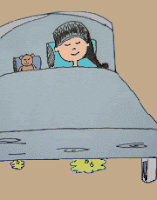Nocturnal enuresis (bed-wetting) is one of many issues Aspergers (AS) and High-Functioning Autistic (HFA) kids face. In comparison, it is likely a less important problem, but a problem nonetheless. Many of these young people have trouble with nocturnal enuresis, because they have difficulty in toilet training.
Why the difficulty in toilet training? A number of factors are involved:
- Kids on the autism spectrum are not good at imitation, which makes the process of potty training more difficult.
- Some do not even feel the wetness of the bed, which can complicate the training methods to help them overcome nighttime bed-wetting.
- Many of these children are also hypotonic, which is a condition that includes a lax form of muscle control as well as a failure to respond or recognize stimuli (e.g., the need to urinate).
By age 5, nocturnal enuresis remains a problem for about 15 percent of AS and HFA kids.
Causes—
No one knows for sure what causes nocturnal enuresis, but various factors may play a role:
- Hormone imbalance. During childhood, some children don't produce enough anti-diuretic hormones (ADH) to slow nighttime urine production.
- Small bladder. Your youngster's bladder may not be developed enough to hold urine produced during the night.
- Structural problem in the urinary tract or nervous system. Rarely, nocturnal enuresis is related to a defect in the youngster's neurological system or urinary system.
- Chronic constipation. A lack of regular bowel movements may make it so your youngster's bladder can't hold much urine, which can cause nocturnal enuresis at night.
- Diabetes. For a youngster who's usually dry at night, nocturnal enuresis may be the first sign of diabetes. Other signs and symptoms may include passing large amounts of urine at once, increased thirst, and fatigue and weight loss in spite of a good appetite.
- Inability to recognize a full bladder. If the nerves that control the bladder are slow to mature, a full bladder may not wake your youngster — especially if your youngster is a deep sleeper.
- Sleep apnea. Sometimes nocturnal enuresis is a sign of obstructive sleep apnea, a condition in which the youngster's breathing is interrupted during sleep — often because of inflamed or enlarged tonsils or adenoids. Other signs and symptoms may include snoring, frequent ear and sinus infections, sore throat, and daytime drowsiness.
- Stress. Stressful events — such as becoming a big brother or sister, starting a new school, or sleeping away from home — may trigger bed-wetting.
- Urinary tract infection. A urinary tract infection can make it difficult for your youngster to control urination. Signs and symptoms may include bed-wetting, daytime accidents, frequent urination, bloody urine and pain during urination.
Risk factors—
Several factors have been associated with an increased risk of nocturnal enuresis, including:
- Attention-deficit/hyperactivity disorder (ADHD). Nocturnal enuresis is more common in kids who have ADHD.
- Family history. If both of a youngster's parents wet the bed as kids, their youngster has an 80 percent chance of wetting the bed, too.
- Sex. Nocturnal enuresis can affect anyone, but it's twice as common in boys as girls.
Complications—
- Although frustrating, nocturnal enuresis without a physical cause doesn't pose any health risks. The guilt and embarrassment a youngster feels about wetting the bed can lead to low self-esteem, however.
- Rashes on the bottom and genital area may be an issue as well — especially if your youngster sleeps in wet underwear. To prevent a rash, help your youngster rinse his or her bottom and genital area every morning. It also may help to cover the affected area with a petroleum ointment at bedtime.
When to Call the Doctor—
Nocturnal enuresis that begins abruptly or is accompanied by other symptoms can be a sign of another medical condition, so talk with your doctor. The doctor may check for signs of a urinary tract infection (UTI), constipation, bladder problems, diabetes, or severe stress. Call the doctor if your youngster:
- begins to wet his or her pants during the day
- complains of a burning sensation or pain when urinating
- has swelling of the feet or ankles
- has to urinate frequently
- is drinking or eating much more than usual
- starts misbehaving at school or at home
- suddenly starts wetting the bed after being consistently dry for at least 6 months
- your youngster is still wetting the bed at age 7 years
Also let the doctor know if you're feeling frustrated with the situation or could use some help. In the meantime, your support and patience can go a long way in helping your youngster feel better about the bedwetting.
Preparing for a doctor’s appointment—
You're likely to start by seeing your family doctor or your youngster's pediatrician. However, he or she may refer you to a doctor who specializes in urinary disorders (pediatric urologist or nephrologist). Here's some information to help you get ready for your appointment, and what to expect from your doctor:
1. Make a list of all medications, vitamins and supplements that your youngster is taking.
2. Write down any symptoms, including any that may seem unrelated. It can also be helpful to keep a diary of your youngster's bathroom visits. Write down when your youngster goes to the toilet, as well as whether or not he or she felt a sense of urgency to urinate. Also make note of how much your youngster has had to drink, especially after dinner.
3. Write down key personal information, including any major stresses or recent life changes.
4. Write down questions to ask your youngster's doctor. For example:
- Are there any alternatives to the primary approach that you're suggesting?
- Are there any brochures or other printed material that I can take home with me?
- Are there any drinking or dietary restrictions that my youngster needs to follow?
- Are there any side effects to medications?
- Is there a generic alternative to the medicine you're prescribing?
- What treatments are available, and which do you recommend?
- What websites do you recommend visiting?
- What's causing my youngster to wet the bed?
- When might he or she outgrow wetting the bed?
Your time with your youngster's doctor may be limited, so preparing a list of questions can help you make the most of your time together. List your questions from most important to least important in case time runs out.
Your doctor is likely to ask you a number of questions. Being ready to answer them may reserve time to go over any points you want to spend more time on. Your doctor may ask:
- Does the nocturnal enuresis seem to be triggered by certain foods, drinks or activities?
- Does your youngster complain of pain or other symptoms when urinating?
- Has your youngster always wet the bed, or did it begin recently?
- How often does your youngster wet the bed?
- If you're divorced, does your youngster live in each parent's home and does the nocturnal enuresis occur in both homes?
- Is there a family history of bed-wetting?
- Is your youngster dry during the day?
- Is your youngster facing any major life changes or other stresses?
Try to be patient and understanding with your youngster. Nocturnal enuresis is a source of anxiety and frustration for your youngster. He or she isn't wetting the bed on purpose. While you're waiting to see the doctor, try limiting the amount your youngster drinks in the evening.
Tests and diagnosis—
Your youngster will need a physical exam. Depending on the circumstances, urine tests may be done to check for signs of an infection or diabetes. If the doctor suspects a structural problem with your youngster's urinary tract or another health concern, your youngster may need X-rays or other imaging tests of the kidneys or bladder.
Treatments and drugs—
Most kids outgrow nocturnal enuresis on their own. If there's a family history of bed-wetting, your youngster will probably stop nocturnal enuresis around the age the parent stopped bed-wetting. Generally, your youngster will be your doctor's guide to the level of necessary treatment. If your youngster isn't especially bothered or embarrassed by an occasional wet night, home remedies may be the ideal treatment. However, if your grade school youngster is terrified about wetting the bed during a sleepover, he or she may be more motivated to try additional treatments.
• Calm the bladder. If your youngster has a small bladder, an anticholinergic drug such as oxybutynin (Ditropan) or hyoscyamine (Levsin) may help reduce bladder contractions and increase bladder capacity. Side effects may include dry mouth and facial flushing.
• Change a youngster's sleeping and waking pattern. The antidepressant imipramine (Tofranil) may provide nocturnal enuresis relief by changing a youngster's sleeping and waking pattern. The medication may also increase the amount of time a youngster can hold urine or reduce the amount of urine produced. Imipramine has been associated with mood changes and sleep problems. Caution is essential when using this medication, because an overdose could be fatal. Because of the serious nature of these side effects, this medication is generally recommended only when other treatments have failed.
• Medication. Your youngster's doctor may prescribe medication to stop bed-wetting. Sometimes a combination of medications is most effective. There are no guarantees, however, and medication doesn't cure the problem. Nocturnal enuresis typically resumes when the medication is stopped.
• Moisture alarms. These small, battery-operated devices — available without a prescription at most pharmacies — connect to a moisture-sensitive pad on your youngster's pajamas or bedding. When the pad senses wetness, the alarm goes off. Ideally, the moisture alarm sounds just as your youngster begins to urinate — in time to help your youngster wake, stop the urine stream and get to the toilet. If your youngster is a heavy sleeper, another person may need to listen for the alarm. If you try a moisture alarm, give it plenty of time. It often takes at least two weeks to see any type of response and up to 12 weeks to enjoy dry nights. Moisture alarms are highly effective, carry a low risk of relapse or side effects, and may provide a better long-term solution than medication does.
• Slow nighttime urine production. The drug desmopressin acetate (DDAVP) boosts levels of a natural hormone (anti-diuretic hormone, or ADH) that forces the body to make less urine at night. Although DDAVP has few side effects, the most serious is the potential for seizures. This can happen if your youngster drinks too much when taking the medication. For this reason, don't use this medication on nights when your youngster drinks a lot of fluids. Additionally, don't give your youngster this medication if he or she has a headache, has vomited or feels nauseous.
Lifestyle and home remedies—
Here are changes you can make at home that may help:
• Adjust the child's diet. AS and HFA children commonly have a poor immune system and resulting food allergies. Because this may be one of the causes of bed wetting, perform an allergy test on the child, with a physician's permission, to rule this possibility out. Common allergies among children on the spectrum are dairy, grain and strawberries or citrus fruit. To test the child, take one of these categories of food at a time out of her diet completely for two weeks. At the end of the two-week period, give her the food item on an empty stomach. If she is allergic, she will react within 15 to 60 minutes. Continue on to a different category every two weeks until you have tested all three food categories.
• Avoid beverages and foods with caffeine in the evening. Caffeine may increase the need to urinate, so don't give your youngster drinks, such as cola, or snacks that have caffeine, such as chocolate, in the evening.
• Consider a bed-wetting alarm. A common problem among bed wetting in AS and HFA children is that they can't recognize the feeling of moisture. Also, some of these children are not bothered by wetting their bed. Bed-wetting alarms are waterproof censors that attach to bed sheets. When moisture occurs, a beeping alarm goes off. This wakes them up and prompts them to finish going to the bathroom in the restroom. It seems to be very effective for many children on the spectrum, but there are exceptions. Some children get very frightened by the sound, so it is important to consider the child's personality and consult a physician before attempting to use a bed-wetting alarm.
• Encourage double voiding before bed. Double voiding is urinating at the beginning of the bedtime routine and then again just before falling asleep. Remind your youngster that it's OK to use the toilet during the night if needed. Use small night lights, so your youngster can easily find the way between the bedroom and bathroom.
• Encourage regular toilet use throughout the day. During the day and evening, suggest that your youngster urinate once every two hours, or at least enough to avoid a feeling of urgency.
• Limit how much your youngster drinks in the evening. Having around 8 ounces of liquid to drink (about .25 liter) in the evening is generally enough, but check with your doctor to find out what's right for your youngster. There's no need to limit how much your youngster drinks, but some experts feel a good rule of thumb is for kids to have 40 percent of their liquids between 7 a.m. and noon, another 40 percent between noon and 5 p.m., and just 20 percent of their daily fluids after 5 p.m. However, don't limit fluids if your youngster is participating in sports practice or games in the evenings.
• Observe the child's bathroom behavior during the day. It is important to be aware of the level of his current potty training capability. Not being potty trained during the day can point to a developmental problem of not being able to imitate the concept of going to the bathroom in the first place. In this case, you should be patient and potty train the child in the same fashion you would most children. AS and HFA children may take longer to understand the concept as a whole. If they go to the bathroom with no problem during the day, you can assure yourself that they are able to grasp the concept. If this is the case, you need to explore other options of what the problem might be during the night.
• Take advantage of dry protection. For the comfort of the child as well as creating an easier clean up for you, use plastic mattress liners. In addition, have the child wear adult disposable moisture-locking underpants to bed. If needed, she may also wear them throughout the day. This will help contain most of the moisture from her pajamas and the bed sheets. Use these dry protection methods while you are working with the child's bed wetting situation to allow more comfort for both of you.
• Treat constipation. If constipation is a problem for your youngster, your doctor may recommend an over-the-counter stool softener.
• Wake the child up every few hours in the middle of the night and explain to him that he needs to go to the bathroom. Take him to the restroom. If you do this consistently every few hours for a few weeks, it will help implant the idea in his head to get up when he has to go to the bathroom.
Alternative medicine—
Many people are interested in trying alternative therapies to treat bed-wetting, and several therapies, such as hypnosis and acupuncture, appear to be somewhat effective. However, other therapies currently don't have evidence to support their use.
- Acupuncture. This treatment involves the insertion of fine needles in specific parts of the body. Acupuncture may be effective for some kids.
- Chiropractic therapy. The idea behind chiropractic therapy is that if the spine is out of alignment, normal bodily functions will be affected. However, there's little evidence regarding the use of chiropractic therapy for the treatment of bed-wetting.
- Diet. Some people believe that certain foods affect bladder function and that removing these foods from the diet could help decrease bed-wetting. More study is needed.
- Homeopathy and herbs. Although some people are interested in homeopathic remedies and herbal products, none of these has been proven effective in clinical trials.
- Hypnosis. Small trials of hypnosis coupled with suggestions of waking up in a dry bed or visiting the toilet in the night found that this therapy may help some kids stay dry throughout the night.
Be sure to talk to your youngster's doctor before starting any alternative therapy. Some treatments can be just as powerful as prescription medications or surgeries. Make sure the alternative therapies you choose are safe for your youngster and won't interact with other medications your youngster may take.
Coping and support—
Kids don't wet the bed to irritate their moms and dads. Try to be patient as you and your youngster work through the problem together.
- Be sensitive to your youngster's feelings. If your youngster is stressed or anxious, encourage him or her to express those feelings. When your youngster feels calm and secure, nocturnal enuresis may become a thing of the past.
- Celebrate effort. Don't punish or tease your youngster for wetting the bed. Instead, praise your youngster for following the bedtime routine and helping clean up after accidents.
- Enlist your youngster's help. Perhaps your youngster can rinse his or her wet underwear and pajamas or place these items in a specific container for washing. Taking responsibility for nocturnal enuresis may help your youngster feel more control over the situation.
- Plan for easy cleanup. Cover your youngster's mattress with a plastic cover. Use thick, absorbent underwear at night to help contain the urine. Keep extra bedding and pajamas handy.
With reassurance, support and understanding, your youngster can look forward to the dry nights ahead.
Highly Acclaimed Parenting Programs Offered by Online Parent Support, LLC:
==> How To Prevent Meltdowns and Tantrums In Children With High-Functioning Autism and Asperger's
==> Parenting System that Significantly Reduces Defiant Behavior in Teens with Aspergers and High-Functioning Autism
==> Launching Adult Children with Asperger's and High-Functioning Autism: Guide for Parents Who Want to Promote Self-Reliance
==> Teaching Social Skills and Emotion Management to Children and Teens with Asperger's and High-Functioning Autism
==> Parenting Children and Teens with High-Functioning Autism: Comprehensive Handbook
==> Unraveling The Mystery Behind Asperger's and High-Functioning Autism: Audio Book
==> Highly Effective Research-Based Parenting Strategies for Children with Asperger's and High-Functioning Autism
____________________
Do you need the advice of a professional who specializes in parenting children and teens with Autism Spectrum Disorders? Sign-up for Online Parent Coaching today.






.jpg)


